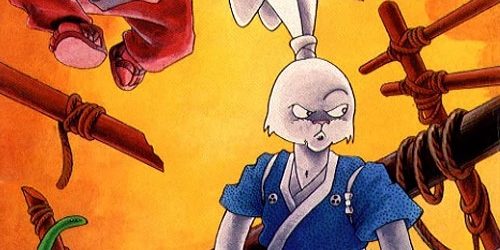Samurai Warrior: The Battles of Usagi Yojimbo, created by Stan Sakai as an homage to japanese culture and cinema, it sits among the cult comic books of the 80s. Still being published today, the episodic comics revolve around the adventures of an antromoporphic samurai rabbit, with a mature and serious approach to japanese folk legends and classic Kurosawa movies.
Because of the success of cartoon rabbits (Roger Rabbit first among them) in the late 80s, the comic became popular, with Usagi appearing alongside the Ninja Turtles and having a tie-in game. Weirdly enough, that was all the media excursions the character deserved, we never even got a full length movie. The action adventure game closely follows the comics’ themes and tone. Incredibly enough, instead of a cheap tie-in product with little to no relevance to the original story, Usagi was among the few comic book characters of the time to get a “perfect” game.
How did they manage such an incredible feat? Well, let’s find out…
Released in 1988 for the Commodore 64, then ported to Zx Spectrum and Amstrad CPC, Samurai Warrior was published by Firebird and developed by Beam Software, which at the time was the trio of Doug Palmer, Paul Kidd (of Shadowrun fame) and Russel Comte, with Neil Brennan doing the music. It plays like a classic 2D beat ‘em up: the player manoeuvers Usagi, starting from his house and going on about his day. Nothing special plotwise, everything feels true to the episodic nature of the comic book, it is also possible to visit his house for a short “practice” session.
While at its core the gameplay resembles a classic arcade style sidescrolling beat’ em up, or maybe “slash em up”, Samurai Warrior‘s design does many things which modernise the experience beyond expectations. First of all, the player must be wary of the “karma” score, Usagi will lose points and shall commit seppuku if the score gets negative. In order to restore it, our ronin must be respectful of the teachings of Buddha, obeying civic and social laws. He will have to nod in order to salute people of higher status than him, otherwise they will get offended and attack.
He can also salute villagers and zen masters and offer money to starving peasants if a karma boost is needed. Naturally, the player might also choose to go against Buddha’s teachings and run around in an aggressive stance, sword drawn, killing innocent animals in sight. In the long run, that kind of attitude will attract unwanted attention and shall be hurtful against the score. The masters will usually respond to the greetings and also gift the player with a Zen saying, all real ones taken directly from the book “Zen Flesh, Zen Bones”. As it happens, more than one reviewer took them as serious clues as to what do next, going on trying to “find a Buddha on the road to kill“.

On the road, the ronin will mostly encounter ninjas that, as the black-clad warriors are wont to do, hide in the shadows or on trees, waiting for the right moment to ambush Usagi. Thus, memorization works best in knowing when it is the right time to draw the sword for an attack. Drawing also means Usagi will switch from neutral to aggressive stance, along with going from walking to running, which is also required to clear ravines and holes in the ground. Other tougher enemies will be antromorphic rhinos and rabbits, which will sometime ask Usagi for a first blood duel. Interestingly enough, they are usually true to their word and will sheath their swords after the first blow.
The hardest enemies are the zen masters, which are lightning fast stick-wielding fighters and are better left unprovoked. Swordfighting is not overly complicated, not surprising since the C64 joystick has only one button: it is possible to charge a slash as long as it is required, execute a quick sideswipe and a parry. The whole mnemonic process of memorizing the right moment to greet people, when to draw your sword so as not to attract attention along with swinging and parrying, almost transforms the short playthrough of Samurai Warrior into a perfectly choreographed dance. A sort of Zen meditation ritual, if you will. The boss battles are no exception, since all out vicious attack will get Usagi killed in a matter of seconds. A balance of defense and attack is the best strategy.
The possibility to choose between alternate paths (a C64 version exclusive) grants the player multiple replays, sensible choice since the game itself is pretty short, a single run lasting no more than 15 minutes. Apparently the game was supposed to be much more complex and longer, but hardware limitations and the short development cycle forced Beam Software to cut back on the features. Still, even though it could have been much more, Samurai Warrior feels and plays very closely to a simulation of a “day in the life of Usagi Yojimbo”. Thinking about it, it starts at dawn, goes through meeting people in villages and forests, stopping to eat at restaurants or to gamble. The game’ soundtrack also works on different layers, presenting three tracks for different moods, like walking, attacking and death.
Samurai Warrior: The Battles of Usagi Yojimbo, a 1988 beat em up, featured: a punishment/reward system, multiple paths and playthroughs, attacking and parrying and, last but not least, NPCs that react to the player’s current and past choices. All this in a fifteen minute playthrough and with less than half a megabyte, probably the closest the C64 could get in 1988 to serious 16 bit gameplay, which was not even a thing at the time! Really, who said that games have to be 15 hours long in order to be engage the player? Amazing that many later beat em ups do not even approach the level of complexity shown by Samurai Warrior.
The Commodore 64 version, among with having more gameplay features, is definitely the superior one. The Amstrad CPC version is graphically more colorful, but less varied and gameplay is slow as molasses. The ZX Spectrum is slightly better, even though there are no Zen masters and dialogue is pretty limited. Both of these versions are also, apparently, missing the ending scene, for some reason.
Samurai Warrior: The Battles of Usagi Yojimbo is one of those very rare instances where the game design is so impressive and polished, that finding something that does not work or to complain about is a moot exercise. Clearly, it could have been much more than a “good 8 bit game” with a longer development cycle. Even, if it was released for the Amiga in 1989 Usagi could have been a bonafide beat em up classic, instead of the sort of cult classic that it is today. But that is legitimately the only complain I can think of: for a tie-in game for 8-bit computers in 1988, it edges very closely to a perfection as it could get.
It controls beautifully, graphically impressive (I love Usagi’s expressions in the upper left), the attention to detail, like the changing musical tracks, is also a welcome addition. But, above all, Samurai Warrior is a comprehensive and respectful tie-in product, which fully graps and commands the themes and mood of the original comic. Heartily recommended.
Thank you for reading.
If you would like to help me to keep the project running, be sure to check out my patreon or alternatively, offer me a coffee.





